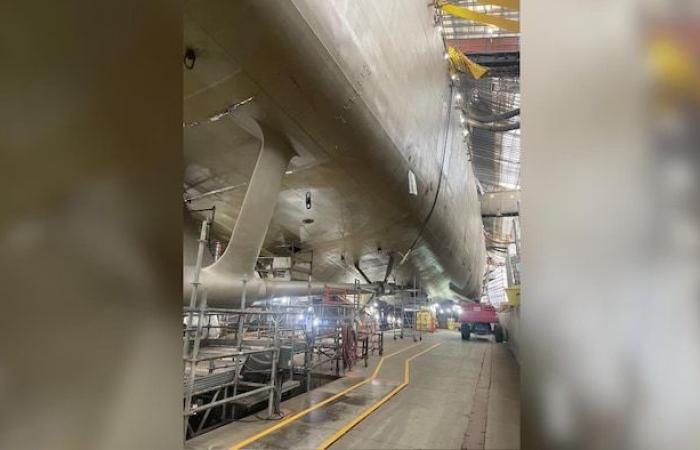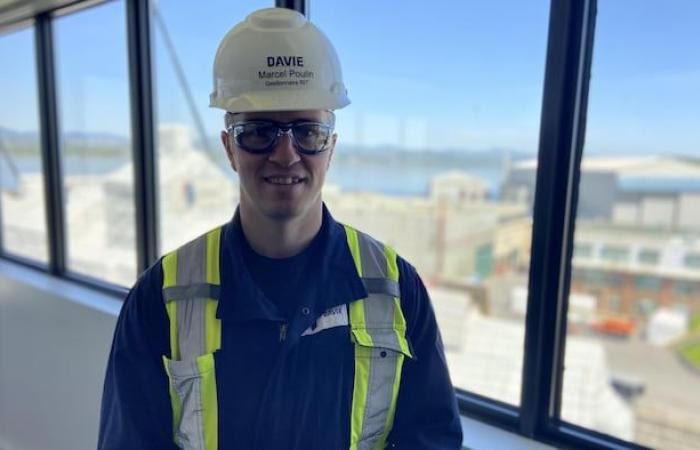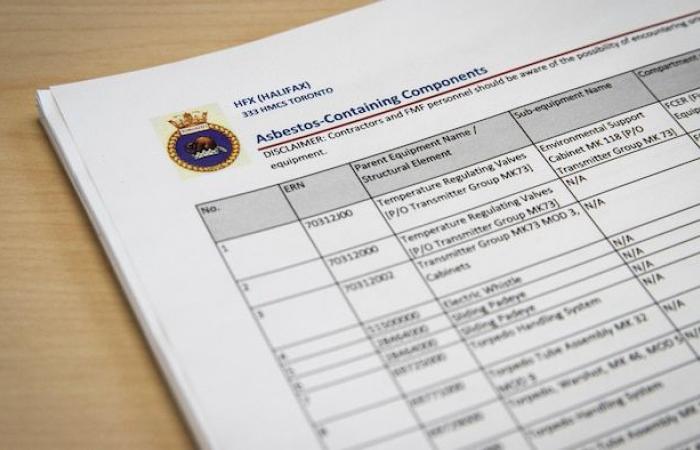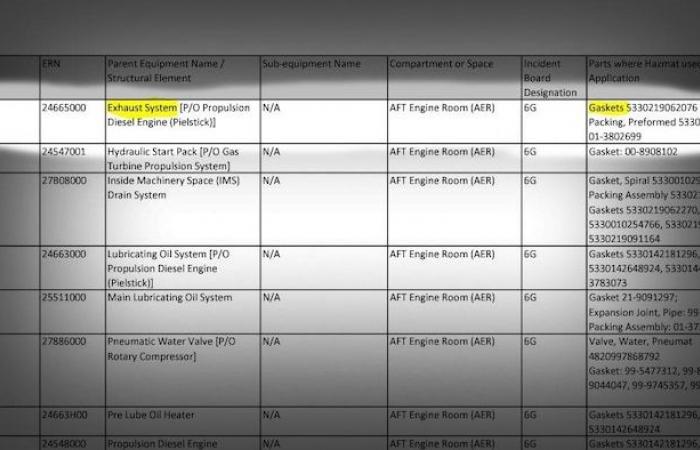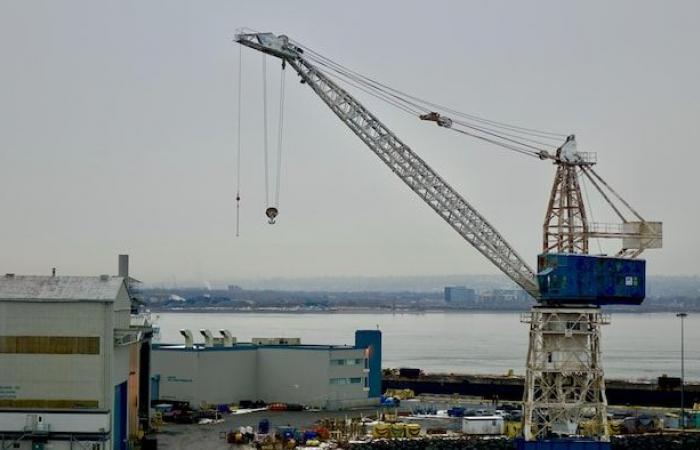Workers at the Davie shipyard in Lévis were exposed to asbestos dust even though they were not adequately protected, - has learned.
The incident occurred on October 17 aboard the NCSM Toronto. The Royal Canadian Navy frigate is currently docked at the Lorne Dry Dock, where it is undergoing extensive repairs and upgrades.
Employees having difficulty removing a gasket from the ship’s exhaust system decided to use a rotary tool to remove it, unaware that the gasket in question contained asbestos, a substance carcinogenic in humans.
Open in full screen mode
The HMCS Toronto has been in dry dock at the Davie shipyard for two and a half years. (Archive photo)
Photo: Credit: Facebook/HMCS Toronto / NCSM Toronto
The friction generated by grinding produced the emission of dust composed partly of asbestos.
When they noticed the dust generated by this operation, they immediately identified and reported a potential danger. In accordance with standard procedures, our health and safety team intervened immediately to secure the area
indicates in an email to - Marcel Poulin, director of external affairs and industrial participation at the Davie shipyard.
Investigation of the CNESST
He adds that a qualified environmental team has since thoroughly cleaned the area and that an investigation is underway, in collaboration with the Commission for Standards, Equity, Health and Safety at Work (CNESST). Mr. Poulin emphasizes that the health and safety of personnel are the shipyard’s priority.
We are committed to maintaining the highest safety standards in all our operations and will carefully review the results of the investigation.
A sample of the dust generated by grinding the seal was taken and sent to a laboratory for analysis. The summary of the analysis report written by EMSL Canada inc. mentions that the sample was composed of 2% chrysotile asbestos.
Open in full screen mode
Marcel Poulin serves as Director, External Affairs and Industrial Participation at Chantier Davie Canada. (Archive photo)
Photo: - / Pierre-Alexandre Bolduc
The Davie shipyard was aware that certain seals on board the NCSM Toronto were likely to contain asbestos.
123 things to watch out for
In August 2023, the Department of National Defense (DND) sent him a copy of the ship’s hazardous materials portfolio.
The document, of which we also obtained a copy, identifies 123 components of the frigate potentially containing asbestos, including several seals (gaskets in the document).
Click here to download and view the document in PDF format (New window)

Open in full screen mode
DND provided the Davie shipyard with a document informing it of the presence, on board the HMCS Toronto, of 123 components that could contain asbestos.
Photo : - / Olivia Laperrière-Roy
At the top of the list, an exemption clause (disclaimer) informs contractors and fleet maintenance facility personnel that original ship components containing asbestos may still be on board.
In other words, the asbestos removal work to which the NCSM Toronto has been subject since its commissioning in the early 1990s, have not necessarily removed all asbestos-based elements.
Unlabeled components
However, the Davie shipyard did not see fit to clearly identify the 123 elements in question since none of the tasks to be carried out listed on the work order were supposed to release asbestos dust.
The company considers that the removal of the seal would not have resulted in the release of toxic dust if the workers had been able to remove it using a knife.

Open in full screen mode
According to a source within the company, the exhaust system gasket that contained asbestos corresponds to item No. 85 on the list provided by the DND.
Photo : -
However, the gasket was so stuck to the metal of the exhaust system that workers had to use a grinder.
Not suspecting that the joint contained asbestos, the employees proceeded to remove it without first donning the personal protective equipment required for this type of intervention, which includes an air-purifying respirator and a suit Tyvek type protective cover.
New measure
Since the incident last month, the company has changed its procedures regarding work in areas that may contain asbestos.
Following this event, all components of the ship likely to contain asbestos were labeled, whether or not work was planned on them. This additional measure will reduce the risk of the same error occurring in the future
specifies director Marcel Poulin.

Open in full screen mode
Three of the twelve frigates of the Royal Canadian Navy were built at the Davie shipyard at the turn of the 1990s. (Archive photo)
Photo: - / MARC GODBOUT
The Lauzon Shipyard Workers’ Union (STCNL) did not want to grant us a recorded interview.
On the telephone, its vice-president, Alain Samson, described the incident of October 17 as isolated case
. He judges that the employer is taking appropriate measures to protect its members against the dangers associated with asbestos.
Allegations of negligence
Two union workers we spoke to disagree. They claim to have worked using mechanized tools on numerous elements on the list provided by the MDNwithout having been informed that they potentially contained asbestos.
The work supervisor would have verbally approved the use of rotating tools. Hot work permits would also have been issued for interventions on these components. Both workers asked not to be identified for fear of retaliation. One of them accuses the employer of being negligent with regard to the risks posed by asbestos.
I unknowingly worked on items that likely contained asbestos. I find it irresponsible on the part of the construction site
he denounces.
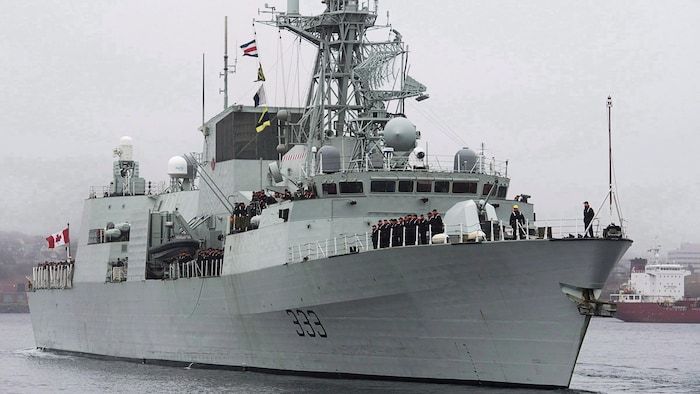
Open in full screen mode
Once it leaves the Davie shipyard facilities, HMCS Toronto will undergo a break-in period. The Department of National Defense expects the ship to be operational again in 2026. (File photo)
Photo: The Canadian Press / Andrew Vaughan
His colleague mentions for his part that workers tried for several weeks, but without success, to obtain from different foremen the list of 123 elements provided by the MDN.
Workers say they fear for their health and that of their colleagues. Everyone at the Davie construction site has been in contact with asbestos in one way or another.
worries the first worker.
Health risks
Their concerns are justified if we refer to the health risks linked to exposure to asbestos. Georges Adib, scientific advisor within the Occupational Health Surveillance, Evaluation and Research Team of theINSPQindicates that asbestos can cause different types of diseases.
The main known pathologies are asbestosis, lung cancer and mesothelioma. They usually appear many years after exposure.
All types of asbestos are recognized as carcinogenic in humans by the International Agency for Research on Cancer, theOMS and other government organizations and agencies
underlines Mr. Adib in an interview with -.

Open in full screen mode
Georges Adib is a chemist and occupational hygienist. He has developed expertise in issues surrounding asbestos exposure.
Photo : -
He adds that there is no clearly defined minimum exposure threshold for suffering from a disease caused by asbestos. This means that one-time exposure, even of low intensity, can lead to lung damage.
We are aware of certain studies in the scientific literature, not necessarily just in Quebec, but across the world [faisant état de] reported cases [de maladies] in individuals who have suffered a small one-off exposure or a fairly massive one-off exposure. Therefore, we cannot exclude the development of a disease
insists the scientific advisor.
Prevent exposures
Hence the importance, for owners of assets (buildings, infrastructure, ships, etc.) and companies called upon to carry out work there, to keep a register of materials containing asbestos to protect employees. an accidental exposure, pleads Georges Adib.
Following a complaint, an inspector of the CNESST visited the shipyard on October 30 accompanied by representatives of the employer party and the STCNL.
The inspector is still gathering information from both parties. A follow-up visit will be carried out as soon as all the information requested by the inspector has been sent to him
mentions the CNESST.
With the collaboration of Audrey Paris and Guylaine Bussière

